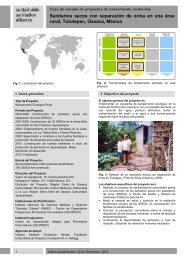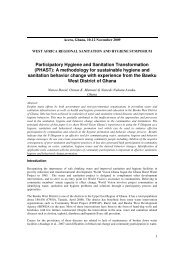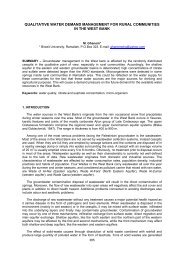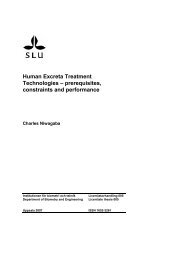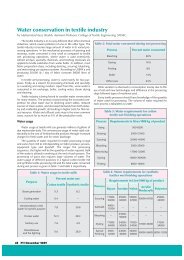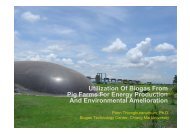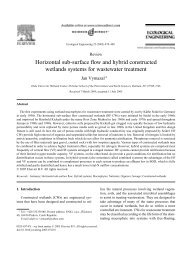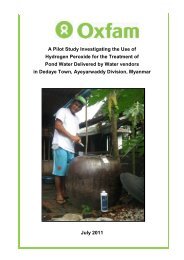Fertigation: Optimizing the Utilization of Water and Nutrients - SSWM
Fertigation: Optimizing the Utilization of Water and Nutrients - SSWM
Fertigation: Optimizing the Utilization of Water and Nutrients - SSWM
Create successful ePaper yourself
Turn your PDF publications into a flip-book with our unique Google optimized e-Paper software.
Violaxanthin<br />
high<br />
light<br />
low<br />
light<br />
An<strong>the</strong>raxanthin<br />
high<br />
light<br />
low<br />
light<br />
Zeaxanthin<br />
In plants suffering from N deficiency, <strong>the</strong> conversion <strong>of</strong> xanthophyll cycle<br />
pigments <strong>and</strong> formation <strong>of</strong> zeaxanthin were enhanced, <strong>and</strong> were accompanied<br />
by chlorophyll bleaching, particularly under high light intensity (Verhoeven<br />
et al., 1997; Kato et al., 2003). In spinach, N-‐deficient plants dissipate a greater<br />
fraction <strong>of</strong> <strong>the</strong> absorbed light energy than N-‐adequate ones: up to 64% <strong>and</strong> only<br />
36%, respectively. This difference was associated with corresponding changes<br />
in xanthophyll cycle pigments: about 65% <strong>of</strong> <strong>the</strong> total xanthophyll pigments<br />
were present as zeaxanthin <strong>and</strong> an<strong>the</strong>raxanthin in N-‐deficient plants compared<br />
with 18% in <strong>the</strong> N-‐adequate plants (Verhoeven et al., 1997). These results<br />
indicate impaired use <strong>of</strong> <strong>the</strong> absorbed light energy in photosyn<strong>the</strong>tic fixation <strong>of</strong><br />
CO2, with consequently enhanced dem<strong>and</strong> for protection against excess light<br />
energy, in N-‐deficient plants. Certainly, <strong>the</strong> reduction in <strong>the</strong> utilization <strong>of</strong> light<br />
energy <strong>and</strong> <strong>the</strong> consequently elevated need for protection against photo-‐<br />
oxidative damage in N-‐deficient plants can be more marked when <strong>the</strong> N<br />
deficiency stress is combined with an environmental stress.<br />
The form in which N is supplied affects plant tolerance to photodamage. The<br />
light-‐induced conversion <strong>of</strong> violaxanthin to zeaxanthin, as a means to dissipate<br />
excess light energy was found to be stronger in bean leaves supplied with nitrate<br />
than in those supplied with ammonium (Bendixen et al., 2001). In good<br />
agreement with <strong>the</strong>se findings, Zhu et al. (2000) demonstrated that nitrate-‐<br />
grown bean plants had higher tolerance to photodamage than ammonium-‐grown<br />
ones. Under very high light intensity ammonium-‐grown plants had, <strong>the</strong>refore,<br />
higher levels <strong>of</strong> lipid peroxidation <strong>and</strong> higher contents <strong>of</strong> antioxidative enzymes.<br />
Potassium, magnesium <strong>and</strong> zinc<br />
Similarly to N deficiency, deficiencies <strong>of</strong> K, Mg <strong>and</strong> Zn also enhance <strong>the</strong><br />
sensitivity <strong>of</strong> plants to photo-‐oxidative damage. When supplies <strong>of</strong> <strong>the</strong>se<br />
nutrients are low, leaf symptoms <strong>of</strong> chlorosis <strong>and</strong> necrosis, <strong>and</strong> disturbances <strong>of</strong><br />
plant growth become more severe when plants exposed to high light intensity<br />
(Marschner <strong>and</strong> Cakmak, 1989; Cakmak <strong>and</strong> Marschner, 1992; Cakmak et al.,<br />
1995; Polle, 1996).<br />
39



